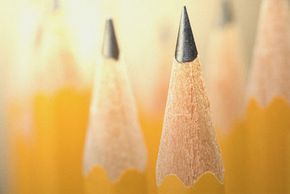The pencil manufacturing process has indeed come a long way. Today, most wooden pencils are mass produced from large blocks of cedar cut into slats. A machine cuts eight grooves, half as deep as the graphite-clay rod is thick, into the slats, and then places rods in each groove. Once the rods are in place, a second grooved slat is glued on top of the first.
When the glue dries, the slats are fed through a cutting machine that cuts the wood into various shapes and divides the slats into eight separate pencils. The seams where the two slats are joined are sanded down and several coats of paint are applied to the pencil, giving it the appearance of a solid structure.
According to Musgrave Pencil Co. Inc, more than 14 billion pencils are produced in the world every year, enough to circle the earth 62 times. This pile of pencils includes a wide variety of styles and widths. If you've ever have taken a fill-in-the-bubble test, you're probably aware that pencils vary in darkness.
The number printed on the side of the pencil indicates hardness and darkness of the graphite core: the higher the number, the harder the graphite core. Because a hard core leaves behind less of the graphite-clay mixture on the paper, it will have a fainter mark than a softer core.
